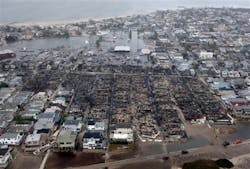NEW YORK (AP) -- People along the battered U.S. East Coast took the first cautious steps to reclaim their daily routines Wednesday, even as the search for superstorm Sandy victims continued and about 20,000 people remained trapped at home in a single New Jersey city. Two major New York airports reopened, and the New York Stock Exchange came back to life.
President Barack Obama landed in New Jersey, which was hardest hit by the storm Monday night, and he took a brief helicopter tour of the devastation with Gov. Chris Christie. "We're going to be here for the long haul," Obama told people at one emergency shelter.
For the first time since the storm pummeled the Northeast, killing at least 62 people and doing billions of dollars in damage, brilliant sunshine washed over New York City, for a while.
At the stock exchange, running on generator power, Mayor Michael Bloomberg gave a thumbs-up and rang the opening bell to whoops from traders. Trading resumed after the first two-day weather shutdown since the Blizzard of 1888.
New York's Kennedy and Newark Liberty airports reopened with limited service Wednesday morning. New York's LaGuardia Airport, which suffered far worse damage and where water covered parts of runways, remained closed. Limited service on the subway, which suffered the worst damage in its 108-year history, would resume Thursday.
It was clear that restoring the region to its ordinarily frenetic pace could take days - and that rebuilding the hardest-hit communities and the transportation networks could take considerably longer.
There were still only hints of the economic impact of the storm.
Forecasting firm IHS Global Insight predicted it would cause $20 billion in damage and $10 billion to $30 billion in lost business. Another firm, AIR Worldwide, estimated losses up to $15 billion.
About 6 million homes and businesses were still without power, mostly in New York and New Jersey. Electricity was out as far west as Wisconsin in the Midwest and as far south as the Carolinas.
In New Jersey, National Guard troops arrived in the heavily flooded city of Hoboken, just across the river from New York City, to help evacuate about 20,000 people still stuck in their homes and deliver ready-to-eat meals. Live wires dangled in floodwaters that Mayor Dawn Zimmer said were rapidly mixing with sewage.
Tempers flared. A man screamed at emergency officials in Hoboken about why food and water had not been delivered to residents just a few blocks away. The man, who would not give his name, said he blew up an air mattress to float over to a staging area.
As New York began its second day after the megastorm, morning rush-hour traffic was heavy as people started returning to work. There was even a sign of normalcy: commuters waiting for the newly returned buses.
A huge line formed at the Empire State Building as the observation deck opened for the first time since the storm.
Tourism returned, but the city's vast and aging infrastructure remained a huge challenge.
Power company Consolidated Edison said it could also be the weekend before power is restored to Manhattan and Brooklyn, perhaps longer for other New York boroughs and the New York suburbs.
Amtrak laid out plans to resume some passenger train service in the Northeast - its busiest corridor - on Wednesday. But flooding continued to prevent service to and from New York's Penn Station. Amtrak said the amount of water in train tunnels under the Hudson and East rivers was unprecedented.
There was no Northeast Regional service between New York and Boston. No date had been set for when it might resume.
In Connecticut, some residents of Fairfield returned home in kayaks and canoes to inspect widespread damage left by retreating floodwaters that kept other homeowners at bay.
"The uncertainty is the worst," said Jessica Levitt, who was told it could be a week before she can enter her house. "Even if we had damage, you just want to be able to do something. We can't even get started."
In New York, residents of the flooded beachfront neighborhood of Breezy Point returned home to find fire had taken everything the water had not. A huge blaze destroyed perhaps 100 homes in the close-knit community where many had stayed behind despite being told to evacuate.
John Frawley, who lived about five houses from the fire's edge, said he spent the night terrified "not knowing if the fire was going to jump the boulevard and come up to my house."
"I stayed up all night," he said. "The screams. The fire. It was horrifying."
___
Contributors to this report included Associated Press writers Angela Delli Santi in Belmar, New Jersey; Geoff Mulvihill and Larry Rosenthal in Trenton, New Jersey; Katie Zezima in Atlantic City, New Jersey; Samantha Henry in Jersey City, New Jersey; Pat Eaton-Robb and Michael Melia in Hartford, Connecticut; Susan Haigh in New London, Connecticut; John Christoffersen in Bridgeport, Connecticut; Alicia Caldwell and Martin Crutsinger in Washington; David Klepper in South Kingstown, Rhode Island; David B. Caruso, Colleen Long, Jennifer Peltz, Tom Hays, Larry Neumeister, Ralph Russo and Scott Mayerowitz in New York.







